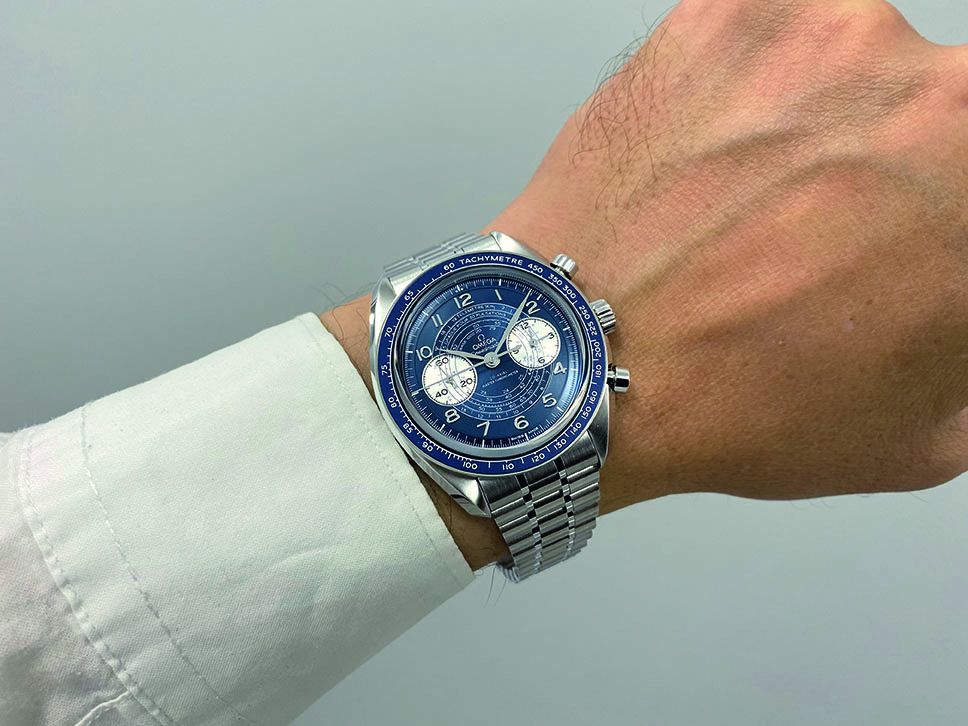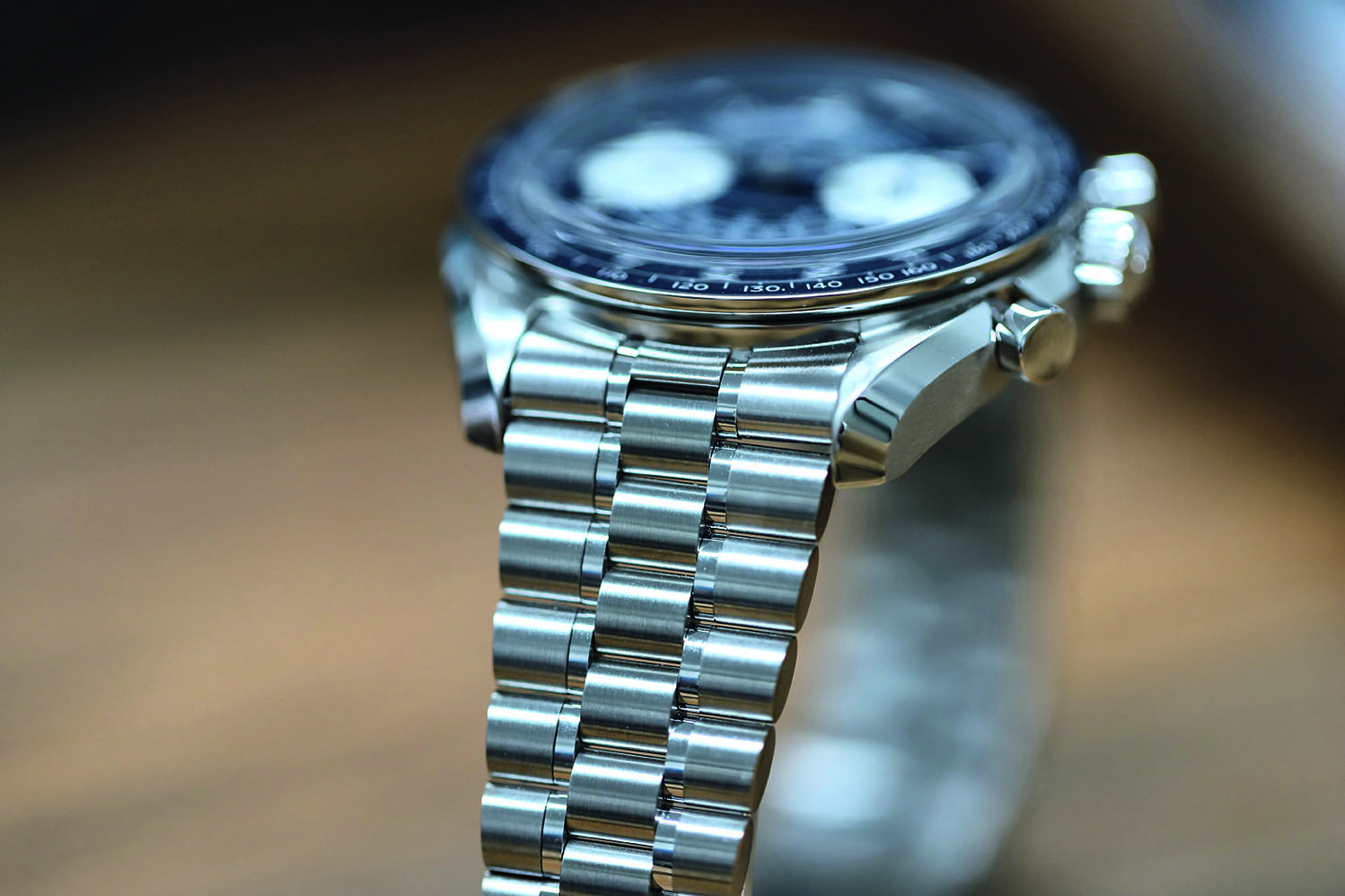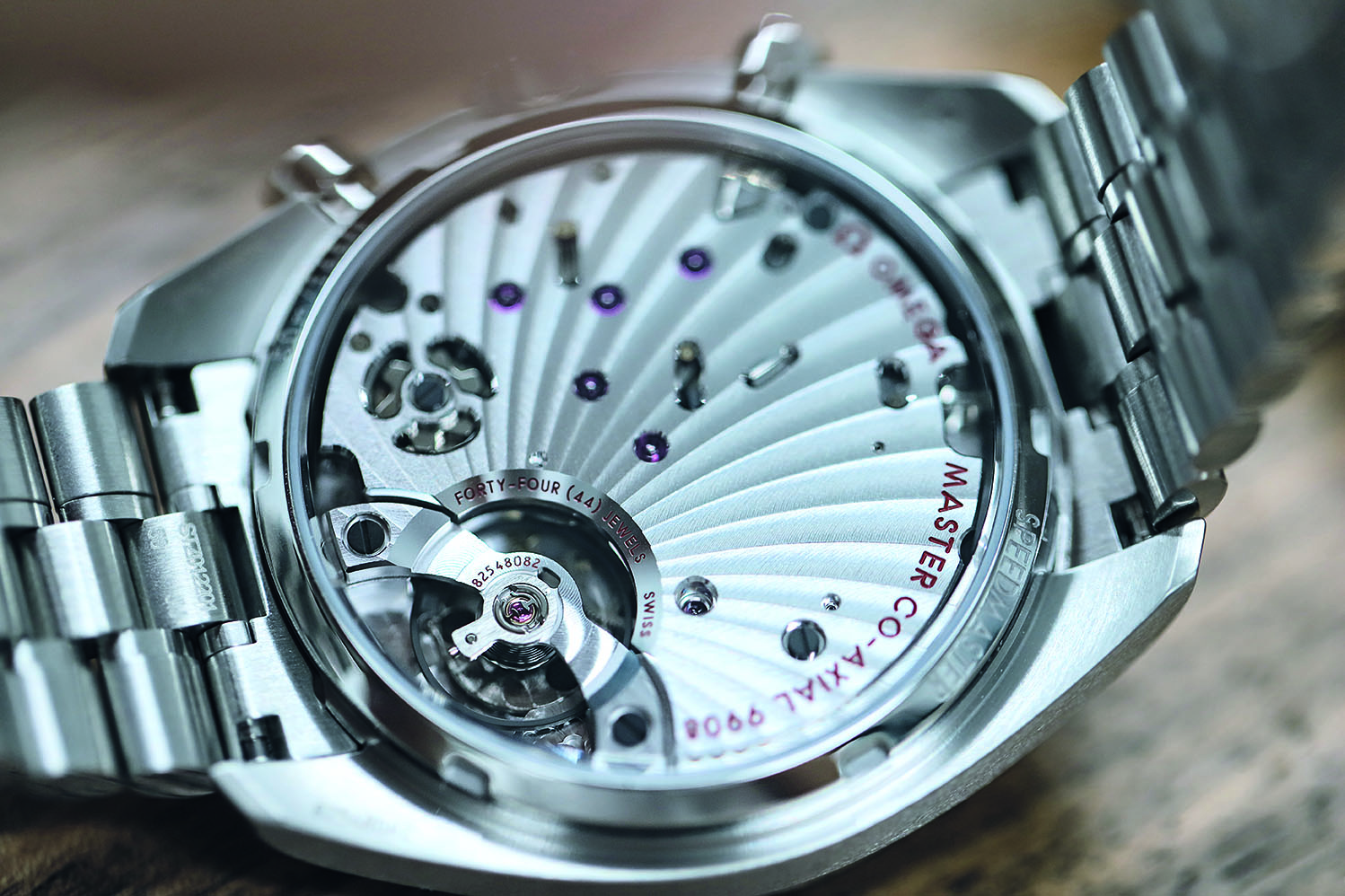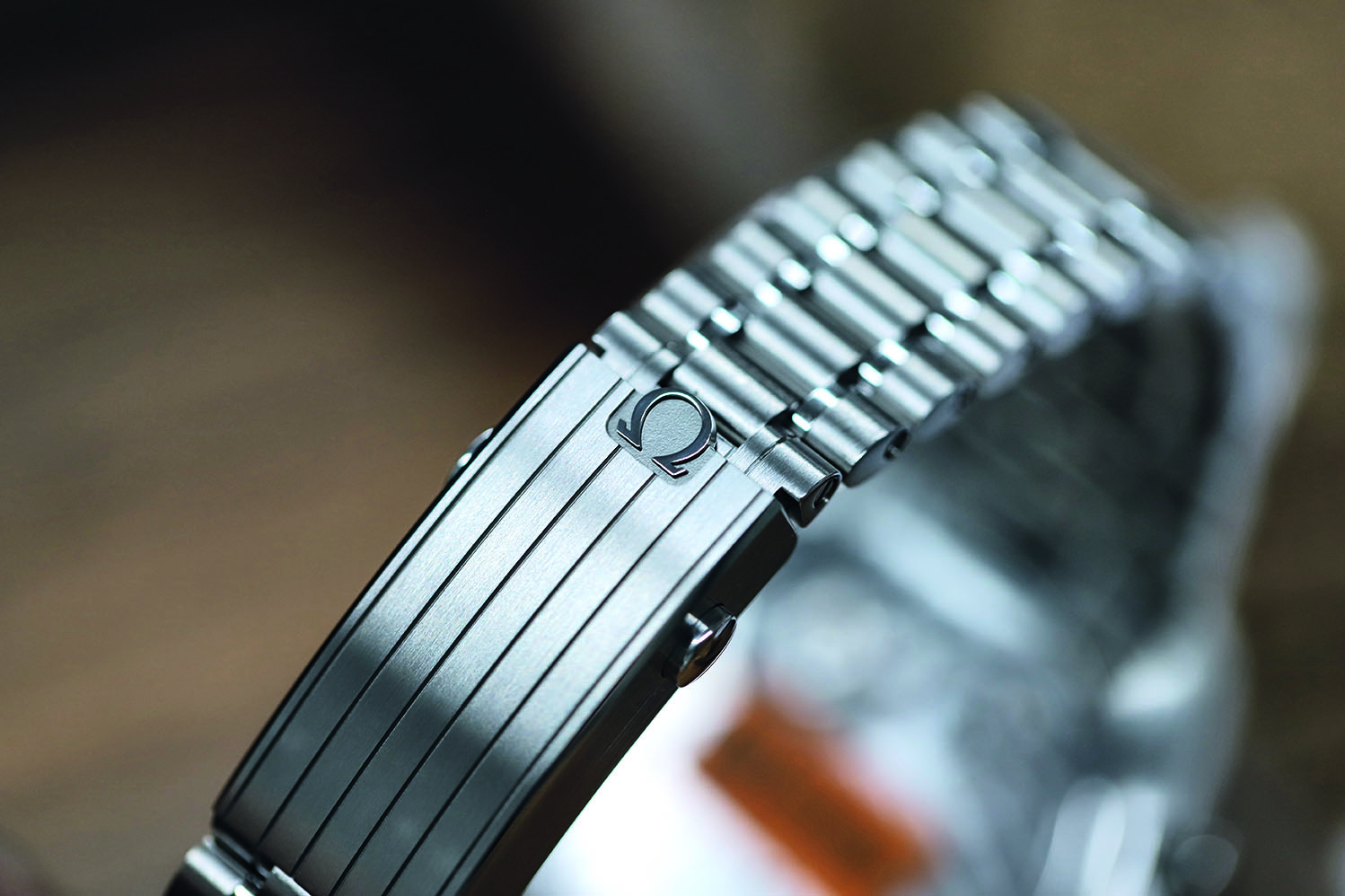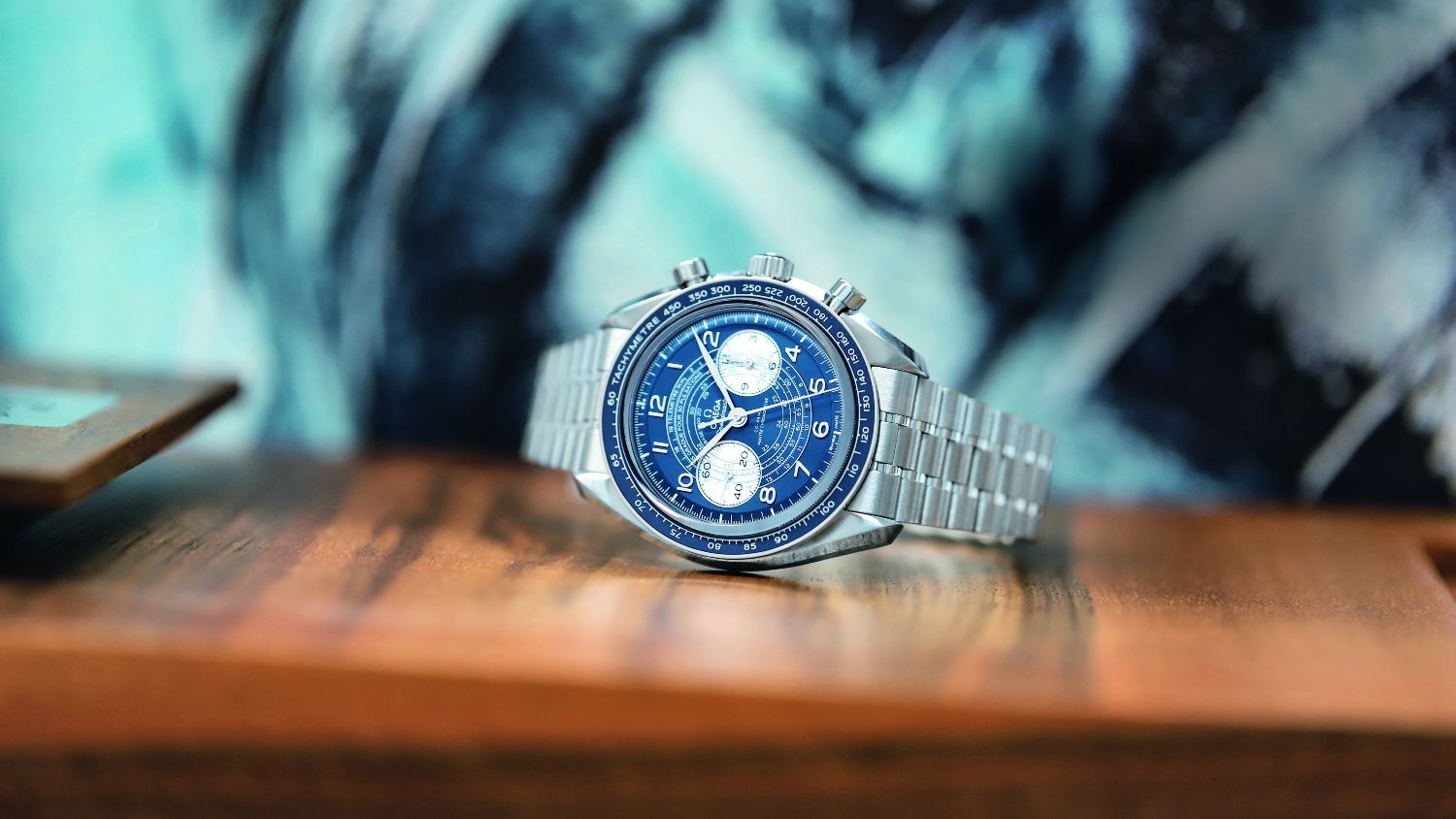The flash of lightning peeked through the blinds as the rain pitter-pattered on the window ledge, and after a short, ominous stretch of silence, a rumble of thunder followed as the Nor’easter bore down on the Hudson Valley. Thanks to the watch I was wearing on my wrist, I was able to time the interval between the lightning flash and the thunderclap to make an educated guess as to how far away the heart of the storm was. The next day, at my annual checkup by my primary care physician in Manhattan, I offered up the other wrist, the bare one, for a check of my pulse rate, which I realised I could then check again myself later, at home, with the same watch. On the ride home on Metro North railroad, I could even use the timepiece to while away the time tracking the train’s speed between stops.
It’s rare that a single watch, even one equipped with a chronograph, can perform such an array of everyday tasks, but the Omega Speedmaster Chronoscope is far from an ordinary watch. It also offers the benefit of being one of the most aesthetically exciting timepieces Omega has offered. Shortly after its debut, Omega answered my plaintive request to review one of the new models in the affirmative, sending one of the handsomest of the seven new references, a model with a deep blue dial and bezel, silver and white detailing, rhodiumed hands and numerals, and an exquisitely finished steel case and bracelet.
The name of the new collection is derived from the Greek words ‘chronos’, meaning time, and ‘scope’, meaning to observe. What sets the Chronoscope apart from its parent model, the classical Speedmaster chronograph that gained renown as the first watch worn on the Moon, is its use of no less than three scales on its front face. On its bezel is the tachymeter scale that has defined the Speedmaster since its debut in 1957 as a useful accessory for auto racing drivers. As fans of such motorsport-inspired timepieces are aware, the tachymeter is designed to be used in concert with the chronograph to calculate how fast one is travelling over a specific period of time. On the dial are two additional scales, arranged in the concentric, snailing style of early Omega wristwatches from the 1940s, to which this new model pays tribute. On the innermost circle is a pulsometer scale, a feature from so-called ‘doctor’s watches’ of the early 20th century, as well as on some modern timepieces from a relative handful of brands, among them Patek Philippe, Montblanc, and Vacheron Constantin. Calibrated to usually 15 or 30 pulsations, the pulsometer (or pulsograph) synchs with the chronograph to measure a patient’s heart rate. Surrounding it is the even more scarcely seen telemeter scale, which allows the user to measure his or her distance from a visible, audible event like the aforementioned thunderclap. Ball Watch’s Fireman Storm Chaser and Graham’s Chronofighter are among a few modern examples of watches in regular production that offer this feature.
Montblanc combines a tachymeter and telemeter in its 1858 Split Second Chronograph, as does Maurice Lacroix in its Pontos Chronograph Monopusher, but watches with all three of the described scales are rare: Germany’s Sinn 900 is one of the few, and its dial is much busier and far less sporty-elegant than Omega’s. And the undisputed granddaddy of multiple complications, Patek Philippe, combines the trio in its Ref. 5975G, a limited edition released in the maison’s 175th anniversary year, but of course that watch in its precious metal case costs much more, even if you’re fortunate enough to find one. Omega, incidentally, has also dabbled in scales other than its hallmark tachymeter in recent years, mostly in vintage-inspired pieces like 2018’s Speedmaster CK 2998, which had a pulsometer-engraved bezel. All of this is to point out that Omega has truly created something special and distinctive here within its flagship chronograph collection.
The Chronoscope’s stainless steel case measures an ample 43mm in diameter and features the telltale barrel-shaped curves of the classic Speedy, with brushed surfaces and polished facets. The chronograph push-buttons are plunger-shaped with a polished finish and subtly curved heads. A light press of a finger suffices to engage the pushers with a metallic snap to send the central stopwatch hand gliding across the dial and its various scales. Another push stops it cold and a follow-up push of the 4 o’clock button whips it back to its starting position. The fluted crown with its relief Omega emblem does not screw down but withdraws with the pull of a fingernail to halt the motion of the seconds hand at 9 o’clock. As one might expect, the lack of a screw-down crown signals that the case’s water resistance is rather pedestrian—50 metres—but it’s unlikely any owner would opt to go swimming or diving with it, especially when Omega makes so many Seamaster models that are perfect for that task.
This version of the Chronoscope has a predominantly navy blue dial with two silvery subdials at 3 and 9 o’clock for the tallying of 12 elapsed chronograph minutes and the running seconds display, respectively. Yes, it’s another iteration of the increasingly popular and now-ubiquitous ‘panda’ design (if there were blue pandas, that is) and it works beautifully.
The 3 o’clock chronograph counter, as it does on many of Omega’s modern Speedmasters, boasts a clever, intuitive reading of the elapsed time interval, with two differently sized hands that overlap when the stopwatch is not in use and the central chronograph seconds hand is standing still at 12 o’clock on the main dial. When the central seconds hand starts moving, the subdial’s minute hand gradually goes along with it, moving to the 1 o’clock position when 60 seconds have been covered. If the chronograph is left on for 60 minutes, the subdial’s hour hand will then move to the 1 o’clock position, etc, up until a maximum of 12 hours. For eg, a chronograph reading of 3 hours and 15 minutes would read 3:15 on the subdial.
The attractive vintage look of the dial is aided by the elegantly curvy Arabic numerals, applied and silvery rhodium-finished. Also rhodium-treated are the 1940s-inspired, leaf-shaped hour and minute hands, the long, javelin-shaped seconds hand and the subdial hands. The snailed texture on the subdials echoes the spiral design of the telemeter and pulsometer scales, which are etched in a light blue that contrasts legibly against both the main dark blue dial as well as the silvered subdials that they cross over. The tachymeter scale’s numerals and indexes are printed in silver on the anodised aluminum bezel insert, whose colour matches the dial’s. The reading of the time is mostly very legible in daylight thanks to the bright shine of the hour numerals and hands, though reading the scales requires a bit of concentration. In keeping with the watch’s retro look, its hands and numerals are bereft of luminous substance, so don’t expect to be able to easily discern the time in the dark.
Behind a wide sapphire pane in the caseback is a view of the movement, Omega’s Calibre 9908, which like the dial is distinctly different visually from most others in Omega’s lineup. It’s a manual-winding version of Omega’s automatic manufacture Calibre 9900 and dominated by a mainplate that features a novel take on the brand’s Côtes de Genève in Arabesque decoration. The familiar pattern radiates outward from the balance wheel rather than from the centre of the bridge, as in predecessors to this calibre. The balance wheel itself oscillates in a round aperture in the lower right and is anchored by a bridge with a jewel in its centre, secured at both ends by screws with blackened heads. A column wheel drives the chronograph mechanism and two DLC-coated barrels store a substantial power reserve of 60 hours, always a plus for a manually wound watch.
As per the standards of modern Omega movements, Calibre 9908 is equipped with a hairspring made of antimagnetic silicon and the co-axial escapement that has been a hallmark of the brand’s in-house calibres since 1999. It also carries the more recently established badge of being a certified Master Chronometer, as determined by the strict criteria of the Swiss Federal Institute of Metrology, or METAS. This means it has passed eight separate, rigorous tests over 10 days to meet standards for precision (between 0 to 5 seconds per day), endurance, and resistance to magnetic fields (up to 15,000 gauss).
The three-link bracelet is supple yet sturdy and tapers elegantly as it flows into the folding clasp with its pair of safety push-buttons. Made of steel, the clasp is graced with a lined pattern and the Greek Omega letter at its attachment point. It’s equipped with a built-in extension that’s useful for sizing, though I still needed to remove several rows of links for a snug fit on my relatively thin wrist. Once sized, the bracelet was highly comfortable, with no snagging or pinching by the rounded links. Style-wise, the watch works especially well with a business casual or semiformal ensemble but can also provide a dressy upgrade to a sport-ier weekend look. With its well-chosen mashup of retro and modern details, the Chronoscope manages to be a very worthy addition to the Speedmaster family while at the same time evoking an era long before anyone could envision human beings, or watches, on the moon.
This story appeared in The Jan-March 2022 Issue of WatchTime India. To subscribe to the print issue, click here.

